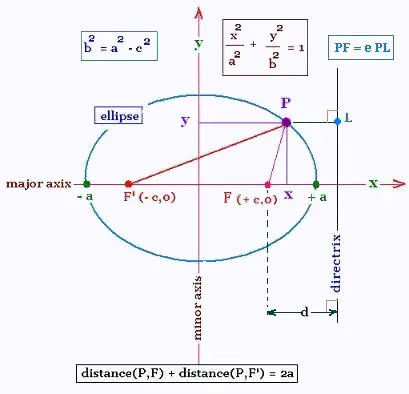Mathematics 5
© The scientific sentence. 2010
|
Mathematics
Conics
Ellipse
1. Ellipse: Construction:

An ellipse is defined as:
dist (P,F) + dist(P,F') = 2a
P is any point on the curve. F and F' are the two
focii of the ellipse; and "dist" is the distance between the
two related points.
Let's express the above equation:
sqrt [(c - x)2 + (0 - y)2 ] +
[(- c - x)2 + (0 - y)2]1/2 = 2a
[(c - x)2 + y2 ]1/2 +
[(- c - x)2 + y2 ]1/2 = 2a
[c2 - 2cx + x2 + y2]1/2
= 2a - [c2 + 2cx + x2 + y2]1/2
c2 - 2cx + x2 + y2
= 4a2 - 4a [c2 + 2cx + x2 + y2]1/2 +
c2 + 2cx + x2 + y2
a [c2 + 2cx + x2 + y2]1/2
= a2 + cx
a2 [c2 + 2cx + x2 + y2]
= a4 + 2cx a2 + c2x2
a2 [c2 + x2 + y2]
= a4 + c2x2
a2 [ x2 + y2] - c2x2
= a2[a2 - c2]
x2[a2 - c2] + a2 y2]
= a2[a2 - c2]
x2 b2 + a2 y2
= a2b2
Then:
x2/ a2 + y2/ b2 = 1
x2/ a2 + y2/ b2 = 1
That is the equation of an ellipse.
2. Ellipse: Polar coordinates:
2.1. Eccentricity of an ellipse

The eccentricity "e" of a conic is defined as the ratio :
e = dist(P,F)/dist(P,L)
Applied to the point P = A, and then
to the point P = A', yields:
e = dist(A,F)/dist(A,L)
e = (a - c)/(d - a) (1)
e = dist(A',F)/dist(A',L)
e = (a + c)/(d + a) (2)
Solving for "e":
Adding (1) and (2) gives:
ed - ea = a - c
ed + ea = a + c
2ed = 2a, then:
e = a/d, or
Subtracting (2) from (1) gives: -2 ea = - 2c, then: e = c/a
e = c/a , with:
0 < e < 1
2.2. Polar equation of en ellipse
Cosine law gives:
PF2 = r2 + c2 - 2rc cosθ
We have :
PL = d - rcosθ
dist(P,F) = e dist(P,L), yields:
sqrt[r2 + c2 - 2r c cosθ] = e(d - r cosθ)
[r2 + c2 - 2r c cosθ]1/2 = e(d - r cosθ)
r2 + c2 - 2r c cosθ = e2d2 +
e2 r2 cos2 θ - 2rde2 cosθ
r2[1 - e2 cos2 θ] + 2r cosθ [ de2 - c] + c2
- e2d2 = 0
Since ed = a, ae = c, and b2 = a2 - c2 then:
r2[1 - e2 cos2 θ] = b2
r = b/[1 - e2 cos2 θ]1/2
r = b/[1 - e2 cos2 θ]1/2 =
[(a2 - c2)/(1 - e2 cos2 θ)]1/2
To simplify, lest' consider F = O, that is the focus is at the origin c = 0,
therefore:
ro = dist(F,P) = e dist(P,L)
d - c = do
dist(P,L) = do - rocos θo; then:
ro = e[do - rocos θo]
ro[1 + e cos θo] = edo
ro = edo/[1 + e cos θo]
ro = edo/(1 + e cos θo)
|
|
|